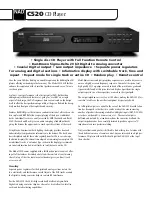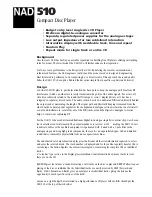
20
Planer Operations
Depth of Cut
Thickness planing refers to the sizing of lumber
to a desired thickness while creating a level
surface parallel to the opposite side of the
board. Board thickness that the planer will
produce is indicated by the
scale
and the
depth-
of-cut
gauge (see
Table Height Adjustment
on
page 10). Preset the planer to the desired
thickness of the finished workpiece using the
gauge. The depth-of-cut is adjusted by raising or
lowering the
planer table
(C, Fig. 5) using the
handwheel
(F, Fig. 5).
The quality of thickness planning depends
on the operator's judgment about the depth
of cut.
The depth of cut depends on the width,
hardness, dampness, grain direction and
grain structure of the wood.
The maximum thickness of wood that can be
removed in one pass is 1/8” for planning
operations on workpieces up to 5-1/2” wide.
The workpiece must be positioned away
from the center tab on the rollercase to cut
1/8”.
The maximum thickness of wood that can be
removed in one pass is 1/16” for planning
operations on workpieces from 5-1/2” up to
12" wide.
For optimum planning performance, the
depth of cut should be less than 1/16”.
The board should be planed with shallow
cuts until the work has a level side. Once a
level surface has been created, flip the
lumber and create parallel sides.
Plane alternate sides until the desired thick-
ness is obtained. When half of the total cut
has been taken from each side, the board
will have a uniform, moisture content and
additional drying will not cause it to warp.
The depth of cut should be shallower when
the workpiece is wider.
When planning hardwood, take light cuts or
plane the wood in thin widths.
Make a test cut with a test piece and verify
the thickness produced.
Check the accuracy of the test cut before
working on the finished product.
Precautions
A thickness planer is a precision
woodworking machine and should be used
on quality lumber only.
Do not plane dirty boards; dirt and small
stones are abrasive and will wear out the
blade.
Remove nails and staples. Use the planer to
cut wood only.
Avoid knots. Heavily cross-grained wood
makes knots hard. Knots can come lose and
jam the blade. Any article that encounters
planer blades may be forcibly ejected from
the planer creating a risk of injury.
Preparing the Work
A thickness planer works best when the
lumber has at least one flat surface. Use a
jointer to create a flat surface.
Twisted or severely warped boards can jam
the planer. Rip the lumber in half to reduce
the magnitude of the warp.
The work should be fed into the planer in the
same direction as the grain of the wood.
Sometimes the wood will change directions
in the middle of the board. In such cases, if
possible, cut the board in the middle so the
grain direction is correct.
Do not plane a board that is
less than 6" long. It is recommended that
when planning short boards you butt them
end to end to avoid kickback and reduce
snipe.
Feeding the Work
The planer is supplied with planer blades
mounted in the cutterhead and infeed and
outfeed rollers adjusted to the correct height.
The planer feed is automatic; it will vary slightly
depending on the type of wood.
Preparation:
Feed rate refers to the rate at which the
lumber travels through the planer.
The operator is responsible for aligning the
work so it will feed properly.
Raise or lower the rollercase to get the
depth of cut desired.
The surface that the planer produces will be
smoother if a shallower depth of cut is used.
Stand on the side that the handle is
attached.
Boards longer than 24” should have
additional support from free standing
material stands. These can be purchased
from JET – Stock # 709207. See Optional
Accessories on page 22.
Summary of Contents for JJP-12
Page 30: ...30 Assembly Drawings Infeed Table Assembly ...
Page 31: ...31 Outfeed Table Assembly ...
Page 32: ...32 Cutterblock Assembly ...
Page 33: ...33 Base Assembly ...
Page 34: ...34 Motor Assembly ...
Page 35: ...35 Planer Table Assembly ...
Page 36: ...36 Fence Assembly ...
Page 38: ...38 Notes ...
Page 39: ...39 Notes ...
















































